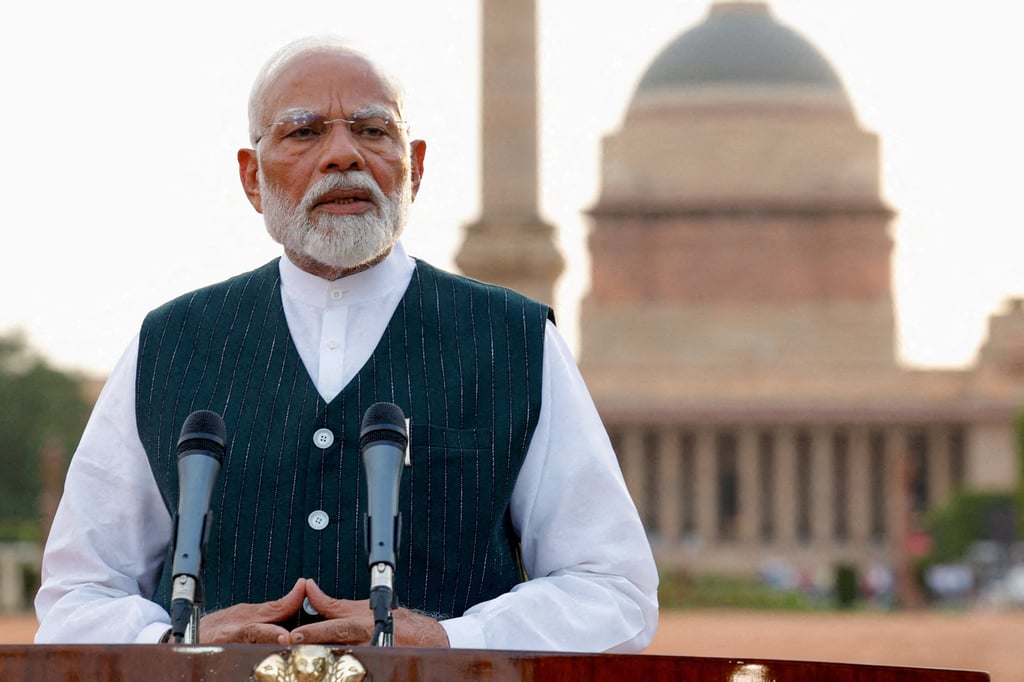India’s new federal budget offers a clear signal from Prime Minister Narendra Modi’s government that economic development, not populist politics, will remain the priority – even as the leader leans heavily on coalition partners for his third term.
The budget unveiled on Tuesday struck a careful balance, promising vital financing for two key coalition states while adhering to a stringent programme to cut the fiscal deficit, a move that analysts say will ensure policy continuity.
Surprising observers, the budget pruned the deficit to 4.9 per cent from an earlier 5.1 per cent estimate for the year ending March 2025, aided by a US$25 billion surplus from the central bank. A high deficit can hamper economic growth, so this fiscal discipline was seen as a positive signal.
Yet with Modi facing criticism over high youth unemployment and growing inequality, the budget also featured schemes to upskill young people and incentives for employers to expand their workforce.
“This is a pretty growth-oriented budget,” said Sujan Hajra, group chief economist and executive director at Mumbai-based Anand Rathi Financial Services. “It has recognised the need for coalition governance and sought to dispel criticism about high youth unemployment and income gaps between the rich and the poor.”

The overall package totalled US$576 billion in outlays, including US$32 billion for rural programmes, US$24 billion over five years for job creation, and more than US$5 billion for the two coalition-ruled states.
Finance Minister Nirmala Sitharaman promised aid for Andhra Pradesh’s new state capital and infrastructure projects in eastern Bihar state, including roads and power stations.
Focus on jobs
Recognising the need to harness India’s vast young population, the budget unveiled a suite of employment-boosting measures. First-time private sector workers will receive a month’s wage, while employers will be partially reimbursed for contributing to the savings of older staff. The government also promised to build shelters for working women, aiming to encourage greater workforce participation.
Beyond direct incentives, the budget earmarked funds to upgrade industrial training institutes – a move meant to upskill the country’s youth. “The government’s efforts to reap India’s demographic dividend are visible,” said HDFC Bank’s chief economist and executive vice-president Abheek Barua.
Nearly half of India’s citizens are under 25 – a demographic advantage that could become a source of social unrest if suitable opportunities aren’t available. Experts say the country needs to create 8 million jobs annually to capitalise on its potential.

12:50
World’s largest population: why it could be a headache for India
World’s largest population: why it could be a headache for India
Yet opinions differ on how effective the budget’s measures will be. While ANZ Bank called them “positive overall”, it also expressed scepticism in a note on Wednesday, saying the modest overall outlay of around 1.1 trillion Indian rupees (US$13.2 billion) is unlikely to significantly ease India’s employment woes. Several low-skill manufacturing sectors, the bank said, are still struggling to regain pre-pandemic production levels.
Others were more optimistic, saying the budgetary measures had the potential to attract more people to join the workforce and support India’s ambition of becoming a global manufacturing hub.
The incentives, while not “game changers”, “will give some inducement to employers to create jobs”, Anand Rathi Financial Services’ Hajra said. “Unorganised gig workers will come towards organised sectors.”
Underpinning this optimism is the government’s broader programme of infrastructure development and red-tape reduction through moves like introducing a centralised sales tax to speed up logistics and shorten the time for debt recovery for bad loans – measures that have fuelled investor bullishness on India’s growth prospects.
Blueprint for reforms
Looking ahead, Finance Minister Sitharaman promised to unveil reforms in sensitive areas like land and labour laws in the coming months.
This builds on the government’s previous attempts to ease acquisition rules and lay-off restrictions – measures that have long been demanded by overseas investors but faced resistance from protest-wary states.
“The budget is more of a blueprint of what is to come in the next five years,” Hajra said. “These are long-drawn processes, but there are lots of missing components in India’s reform processes.”
Hajra believes such reforms are essential if India wants to consistently achieve 7-8 per cent annual growth.

After all, the country is poised to overtake Germany and Japan as the world’s third-largest economy by the end of the decade – part of the ruling BJP’s ambition to transform India into a US$29 trillion, fully developed nation by 2047, its 100th year of independence.
Achieving this vision – of an economy that is about eight times larger and per capita income that has increased sevenfold – will require careful fiscal management.
Economist Vivek Kumar of QuantEco Research expects the government to pursue gradual consolidation after reducing its large deficit. And he remains optimistic about the economic outlook.
While India’s growth rate is expected to slow from 8.2 per cent last year to 6.5-7.5 per cent this year, Kumar believes that rate “should hold” for the next two or three years at least.

Easing inflation could allow the central bank to cut high interest rates, providing a much-needed boost to growth, he said. Kumar is also encouraged by the government’s employment-boosting measures, which he says should gradually strengthen the perennially weak consumption in India’s gross domestic product.
“This is something which was required, and the government has made some attempt to address that,” Kumar said. However, he warned that the budget’s “very short shelf life” of just six months will make it tough to gauge the true impact on job creation.
“If we see continuation of policy, it would have a meaningful impact if executed well,” he said, citing promising initiatives by some states like Maharashtra to expand workforce development programmes.
Despite the challenges, India appears poised to build on its economic momentum. But as always, the true test will be in the follow-through.

